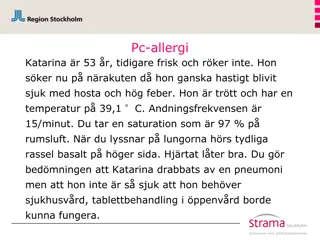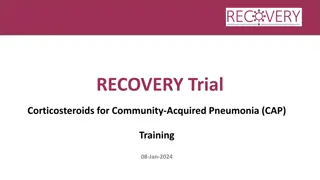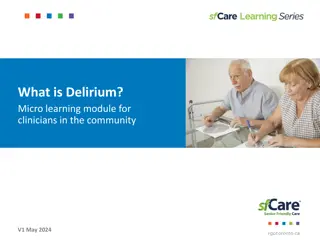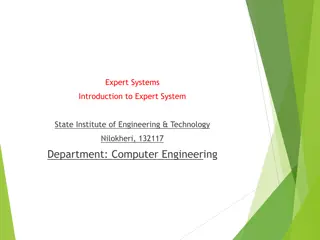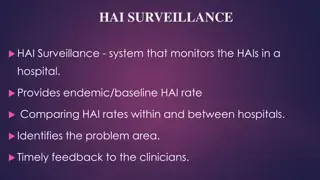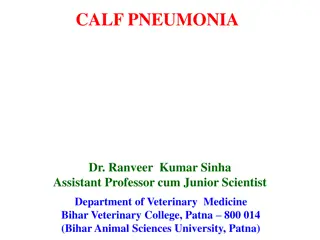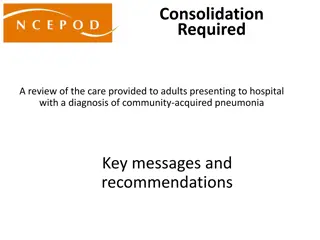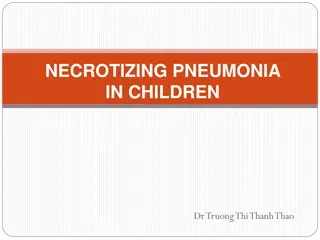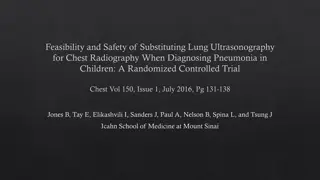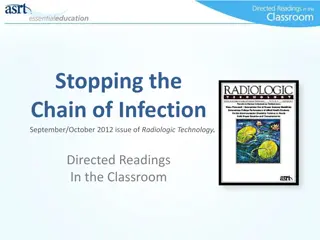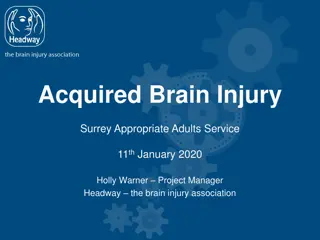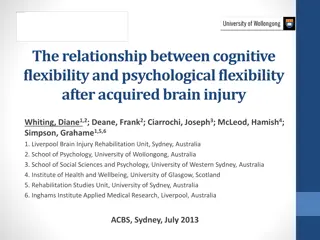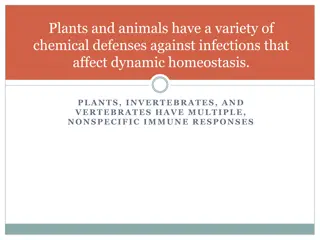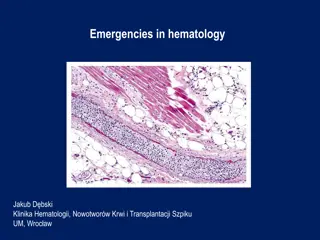DERMATOLOGY AND RHEUMATOLOGY
Staphylococcal Scalded Skin Syndrome (SSSS) is a serious condition characterized by red blistering skin resembling burns. It is caused by toxins from Staphylococcus aureus, leading to exfoliation of the skin. Common in infants, the elderly, and immunocompromised individuals, SSSS requires prompt dia
0 views • 89 slides
The Dust Bowl: Impact of the 1930s Drought
The Dust Bowl of the 1930s was a devastating period marked by severe drought, high winds, and dust storms in the Great Plains. It affected states like Texas, Oklahoma, Kansas, and more, leading to ruined crops, livestock losses, dust pneumonia deaths, and economic hardships. The lack of soil conserv
3 views • 14 slides
Evaluation and Treatment for Pneumonia in Patient with Penicillin Allergy
A 53-year-old woman, Katarina, presents with sudden illness of cough, high fever, and fatigue. With signs of pneumonia, but allergic to penicillin, the decision involves choosing appropriate treatment options such as PcV and considering past allergic reactions and infection history. Evaluating poten
3 views • 20 slides
Nursing Care for Ventilator-Associated Pneumonia (VAP)
Ventilator-Associated Pneumonia (VAP) is defined as lung parenchyma inflammation occurring 48 hours or more after endotracheal intubation and mechanical ventilation initiation. It is a common nosocomial infection in ICU patients, with significant morbidity and mortality rates. Etiology of VAP involv
2 views • 24 slides
Exploring Human Biochemistry: Anatomy, Systems, and Diseases
Delve into the intricate world of human biochemistry through a comprehensive exploration of the anatomy, systems, and diseases affecting the body. From the respiratory and circulatory systems to discussions on common ailments like colds, influenza, and pneumonia, this content provides an insightful
4 views • 42 slides
Understanding Pneumonia: Causes, Classification, and Risk Factors
Pneumonia is an infection of the lower respiratory tract that can be classified anatomically and etiologically. The common causes include bacterial, viral, and fungal pathogens, as well as aspiration pneumonia. Factors such as immune deficiency, overcrowding, and poor hygiene can increase the risk o
10 views • 37 slides
RECOVERY Trial: Corticosteroids for Community-Acquired Pneumonia (CAP) - Overview and Eligibility Criteria
Community-Acquired Pneumonia (CAP) is a common reason for hospitalization globally, with estimated annual fatalities of approximately 2.5 million. The RECOVERY Trial is investigating the use of corticosteroids in patients with CAP suspected or confirmed to be of bacterial origin. Eligibility criteri
1 views • 13 slides
Understanding Delirium: A Micro Learning Module for Clinicians
Delirium is a sudden change in an individual's memory, thinking, and behavior, which requires urgent medical attention. Often misdiagnosed, it can be mistaken for other conditions like depression or dementia. Knowing the signs and symptoms, such as fluctuating confusion, difficulty focusing, and cha
1 views • 9 slides
Understanding Thickened Liquids in Dysphagia Management
Thickened liquids are often recommended for residents with swallowing difficulties to prevent aspiration pneumonia. Recommendations are typically made by speech pathologists, with nursing sometimes adjusting based on availability of therapy. Aspiration pneumonia occurs when substances are inhaled in
2 views • 33 slides
Understanding Acquired Immunity and Its Types
Acquired immunity, also known as adaptive immunity, is the resistance developed by an individual to foreign molecules. It involves antigenic specificity, diversity, immunologic memory, and self/non-self recognition. The two main types of acquired immunity are active immunity, developed from antigeni
3 views • 17 slides
Understanding Immunity: Types and Importance in Health
Immunity is the body's defense system against pathogens, consisting of innate and acquired types. Species immunity offers resistance at a species level, while innate immunity provides the initial defense mechanism. Acquired immunity can be active or passive, providing specific protection to individu
0 views • 17 slides
Understanding Expert Systems in Computer Engineering
Expert systems are interactive computer-based decision tools that utilize facts and heuristics to solve various problems based on knowledge acquired from experts. This system consists of three main components: User Interface, Inference Engine, and Knowledge Base. The User Interface facilitates commu
4 views • 29 slides
What is Pneumonia What to Eat and Avoid in it
Pneumonia is a serious infection that requires careful management, especially in children. Ensuring properhydration and a balanced diet rich in proteins, vitamins, and probiotics can aid in recovery
0 views • 7 slides
Klebsiella Species: Characteristics and Pathogenicity
Klebsiella species, such as K. pneumoniae and K. oxytoca, are gram-negative bacilli commonly found in the microbiota of the intestines, nasopharynx, and feces. They exhibit distinct characteristics like pink mucoid colonies on MacConkey's agar and are known to cause both community-acquired and hospi
0 views • 24 slides
Hospital-Acquired Pressure Injury Case Study: Risk Factors, Interventions, and Follow-Up
This hospital-acquired pressure injury case study covers various aspects such as admission history, risk factors, initial skin assessment, documentation, contributing factors, interventions in use, wound care recommendations, follow-up assessment, and hospital course details. It provides insights in
0 views • 10 slides
Understanding Acquired Traits and Learned Behaviors in Living Organisms
Acquired traits are physical characteristics acquired during a living thing's lifetime, such as scars, and are not passed down from parents. Many acquired traits are also learned behaviors, like reading or flying, which animals develop after birth. Learned behaviors, unlike inherited instincts, are
5 views • 15 slides
Understanding Immunity: Types and Functions Explained
Immunity is the body's defense mechanism against pathogens, encompassing innate and acquired immunity. It involves resistance to infections and foreign antigens, inherited or acquired. Innate immunity provides the first line of defense, while acquired immunity can be active or passive. Species immun
0 views • 33 slides
Accounting Entries in Hire Purchase System for Credit Purchase with Interest Method
In the Credit Purchase with Interest Method of Hire Purchase System, assets acquired on hire purchase basis are treated as acquired on outright credit basis with interest. This method involves initial entries for recording the asset acquisition, down payments, interest on outstanding balance, instal
0 views • 10 slides
Comprehensive Overview of Pneumonia: Causes, Epidemiology, and Management
Pneumonia is an inflammatory lung condition that can be caused by viruses, bacteria, or other microorganisms. It affects millions of people worldwide, with a significant impact on newborn infants. The presentation covers the definition, epidemiology, types, etiology, risk factors, and management of
0 views • 27 slides
Comprehensive Overview of Hospital-Acquired Infection Surveillance System
Surveillance systems like HAI surveillance play a crucial role in monitoring and managing hospital-acquired infections (HAIs) by providing baseline rates, comparing data, and identifying problem areas. This system covers various types of infections such as CAUTI, CLABSI, VAE, and SSI, with specific
0 views • 20 slides
Laboratory-Acquired Infections: Routes of Exposure and Prevention Measures
The content discusses laboratory-acquired infections from 1930 to 2015 and highlights exposure routes such as facial mucous membranes, percutaneous, ingestion, inhalation, and non-traditional routes like eye and nasal cavity. It emphasizes the importance of biosafety practices, identifies GI pathoge
0 views • 21 slides
Understanding the Impact of Acquired Brain Injury on Families
Acquired Brain Injury (ABI) can result from various causes like head trauma, stroke, or substance abuse, leading to emotional turmoil for both the individual affected and their family. A qualitative study highlights the challenges parents face in caring for a child with ABI, likening the experience
0 views • 49 slides
Understanding Calf Pneumonia: Symptoms, Treatment, and Consequences
Calf pneumonia is a significant disease in calves aged one to five months. It is essential to diagnose, treat, and prevent this multifactorial disease for the cattle industry. With types, causes, symptoms, and consequences discussed in detail, the content also covers treatment options like antibioti
0 views • 13 slides
Review of Care for Adults with Community-Acquired Pneumonia
This review focuses on the care provided to adults diagnosed with community-acquired pneumonia (CAP) in hospitals. Key findings include the importance of accurate diagnosis, clinical decision making, and antibiotic management. The study assessed the quality of care through various questionnaires and
0 views • 23 slides
Overview of Necrotizing Pneumonia in Children
Necrotizing pneumonia in children is characterized by necrosis of pulmonary tissue, leading to the formation of small cavities containing necrotic debris or fluid. Staphylococcus Aureus and Streptococcus Pneumoniae are common pathogens. Treatment involves a prolonged course of IV antibiotics tailore
0 views • 34 slides
Antibiotics in Action: Pneumonia Management with Ceftriaxone
Dr. Alyssa Castillo presents strategic antibiotic selection tools for common infections like pneumonia, UTI, and cellulitis, focusing on frequently utilized antibiotics like ceftriaxone. The case study explores treating a 55-year-old pneumonia patient with IV ceftriaxone and discusses additional ant
0 views • 55 slides
Understanding Intangible Assets and Business Combinations in Accounting
In accounting, recognition of intangible assets as assets requires the expectation of future economic benefits flowing to the entity and reliable measurement of the asset's cost. Intangible assets acquired separately are recognized based on their fair value, while those acquired in business combinat
0 views • 23 slides
Understanding Genuine Use and Acquired Distinctiveness in Trademarks
Exploring the concept of genuine use and acquired distinctiveness in trademarks, this content delves into the general principles and specific regulations in the EU, UK, France, and Germany. It discusses the importance of maintaining continuous use of a trademark and the consequences of non-use, as w
0 views • 37 slides
Community Land Trusts: Empowering Communities through Collective Ownership
Community Land Trusts (CLTs) are legal entities run by local volunteers to collectively own and manage property/land, undertake development projects, and secure assets for the community. With priorities set by communities to address local issues like affordable housing and recreation, CLTs provide a
0 views • 13 slides
Understanding Hospital-Acquired Pneumonia: Epidemiology, Etiology, Diagnosis & Treatment
Hospital-acquired pneumonia is a serious infection occurring at least 2 days after hospital admission, leading to complications and mortality. It can be classified into VAP and HCAP, with various predisposing factors and microbiological causes. Recognizing clinical features and prompt treatment are
0 views • 29 slides
Comprehensive Guide to Identifying Carbapenem-Resistant Isolates Without Common Acquired Carbapenem Resistance Genes
Utilize the Isolates Browser on NCBI Pathogen Detection platform to search for carbapenem-resistant isolates without common acquired resistance genes. Follow steps such as using AST phenotypes and AMR genotypes, cross-browser selection, and filters to isolate relevant results. Detailed instructions
0 views • 6 slides
Utility of Lung Ultrasonography in Pediatric Pneumonia Diagnosis
Pneumonia, a leading cause of pediatric mortality globally, presents diagnostic challenges as history and physical exams may not reliably differentiate viral lung infections from bacterial pneumonia. This study explores the feasibility and safety of substituting lung ultrasonography (LUS) for chest
0 views • 21 slides
Understanding Chain of Infection and Preventing Hospital-acquired Infections
Exploring the chain of infection in communicable diseases and the role of radiologic technologists in preventing transmission. Discusses hospital-acquired infections, focusing on Clostridium difficile, and highlights the importance of breaking the chain to safeguard patient health in healthcare sett
0 views • 44 slides
Understanding Acquired Brain Injury: Facts, Challenges, and Stories
Acquired Brain Injury (ABI) is a complex condition that encompasses various causes such as traumatic brain injury, stroke, brain aneurysm, and more. This type of injury can lead to cognitive, physical, and communication difficulties, impacting individuals in profound ways. Survivors of ABI may face
2 views • 24 slides
The Relationship Between Cognitive Flexibility and Psychological Flexibility After Acquired Brain Injury
This study explores how cognitive flexibility and psychological flexibility interact after an acquired brain injury. It examines whether individuals who exhibit cognitive inflexibility can achieve psychological flexibility, considering the impact of cognitive impairments post-injury. Cognitive flexi
0 views • 21 slides
Immune Responses in Plants and Animals: A Comprehensive Overview
Plants and animals have evolved a variety of chemical defenses to combat infections and maintain homeostasis. Innate immunity provides immediate protection through barrier and internal defenses, while acquired immunity offers specific responses involving humoral and cell-mediated mechanisms. Plants
0 views • 26 slides
COMBACTE-CARE: Combatting Bacterial Resistance in Europe - Study Overview
A Phase III study comparing the efficacy, safety, and tolerability of aztreonam avibactam (ATM-AVI) and meropenem colistin (MER-COL) for treating serious infections caused by Gram-negative bacteria, including MBL-producing pathogens. Approximately 300 patients with complicated intra-abdominal infect
0 views • 9 slides
Global Action Plan for Prevention of Pneumonia and Diarrhoea
The Integrated Global Action Plan for Prevention and Control of Pneumonia and Diarrhoea (GAPPD) aims to address the significant impact of these diseases on children under five globally. Released by WHO and UNICEF, the plan focuses on protecting children, preventing diseases, and treating illnesses t
0 views • 17 slides
Emergencies in hematology
A 59-year-old patient with chronic lymphocytic leukemia presented with pneumonia and disease progression. Refusing chemotherapy, he developed severe pneumonia and worsening symptoms. Laboratory tests revealed critical values for leukocytes, hemoglobin, and thrombocytes, along with abnormal biochemis
0 views • 27 slides
Virginia Statewide Acquired Brain Injury Assessment 2013
This report conducted by Virginia Commonwealth University aimed to assess the needs and resources for individuals with acquired brain injuries (ABI) in Virginia. The study identified service needs, gaps, and available resources for ABI survivors and their families/caregivers. Data was gathered throu
0 views • 26 slides


